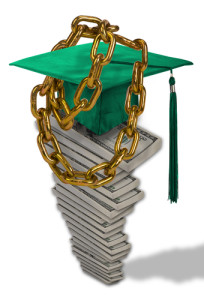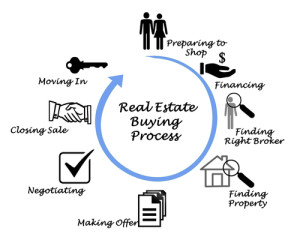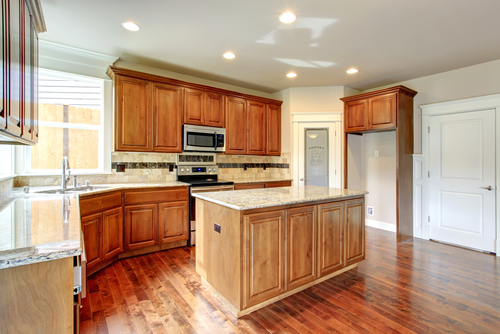Home Loans Especially for College Grads
 With outstanding student loan debt topping $1.2 trillion, and more than 40 million borrowers carrying student loan debt, the age of first-time homebuyers is edging upwards. Among millennials, homeownership is down from 43 percent a decade ago to just 36 percent today. Even though rates on mortgages are relatively low, the overall debt-to-income ratio of potential homebuyers in their 20s and 30s is relatively high.
With outstanding student loan debt topping $1.2 trillion, and more than 40 million borrowers carrying student loan debt, the age of first-time homebuyers is edging upwards. Among millennials, homeownership is down from 43 percent a decade ago to just 36 percent today. Even though rates on mortgages are relatively low, the overall debt-to-income ratio of potential homebuyers in their 20s and 30s is relatively high.
Graduating from college or getting that advanced degree can propel your career, but student loans hanging over your head might make buying that first home more difficult. According to a 2012 study, qualifying for low-downpayment loans—or any loans—for those with higher debt loads due to student loans can be particularly unattainable. But newer options are coming available for successful college graduates that might open up doors for potential homebuyers.
USDA Loans
A specialty loan type geared toward rural housing, the USDA Home Loan Underwriters consider a college degree to be a “compensating factor” when evaluating applications for home loans. They have special ways of calculating student loans that are in deferment or are in an income-based repayment (IBR) status depending on the documentation of your arrangements, so keeping great records on your student loans is really important.
FHA Loans
When calculating the debt-to-income ratio for FHA loans, the Federal Housing Administration calculates loans that are deferred beyond 12 months differently than loans that may require payments to begin sooner. Again, the FHA lender requires supporting evidence regarding your loan’s deferment status. If you are a co-signer on a student loan, your lender’s standards may differ, too.
How can you qualify?
Data from top lenders shows that about an equal number of loans to millennials with student debt are funded as are denied. That means that other factors regarding student loan debt affect approval during underwriting. According to some analyses, a difference in monthly student loan payment amounts of $500 versus $300 can derail a loan, as can a few points one way or the other on a credit score.
Check out new loan products
Standard loan underwriting by Freddie Mac and Fannie Mae may continue to slow home mortgages to graduates with student loans, but some lenders are creating options for graduates in good standing.
Requiring as little as ten percent down, a SoFi mortgage has flexible debt-to-income requirements in its underwriting process for graduates with education debt. While not yet available in all state, these loan products are available in twenty-three states and the District of Columbia. Expansion to other states is in the works.
These mortgages do not require private mortgage insurance (PMI) or loan origination fees, saving new millennial homeowners a little more in the monthly outgo, too. According to their website, loans tend to close in as few as 21 days due to their streamlined underwriting process.
Compliments of Virtual Results




 Buying a home, especially for the first time, is emotional. You’ve saved and scrimped for months—years even—and now you’ve found the home of your dreams. You’re in love and you don’t want someone else to get it.
Buying a home, especially for the first time, is emotional. You’ve saved and scrimped for months—years even—and now you’ve found the home of your dreams. You’re in love and you don’t want someone else to get it. A recent display at the Saloni design fair in Milan, Italy, featured parts of Concept Kitchen 2025, a collaboration between IKEA, the IDEO design firm and Swedish design students. Their exhibit showcases concepts from tables that double as computers and cooktops to food storage appliances that read RFID chips on food packaging that programs the correct storage temperature via “smart induction cooling technology.”
A recent display at the Saloni design fair in Milan, Italy, featured parts of Concept Kitchen 2025, a collaboration between IKEA, the IDEO design firm and Swedish design students. Their exhibit showcases concepts from tables that double as computers and cooktops to food storage appliances that read RFID chips on food packaging that programs the correct storage temperature via “smart induction cooling technology.”

 As a real estate trend, loft living is here to stay. Originally thought of as live/work spaces for artists and musicians, the term “loft” evokes transformed warehouses and industrial spaces with exposed brickwork, open pipes and electrical conduits and other industrial-type accoutrements such as old wood or concrete floors. While the original concept of a loft is the transformation of an old commercial building into big, open living spaces, modern lofts can include new construction and spaces with walls, too. Buyers drawn to loft living include historic artistic residents, young professionals and even empty nesters and Baby Boomers.
As a real estate trend, loft living is here to stay. Originally thought of as live/work spaces for artists and musicians, the term “loft” evokes transformed warehouses and industrial spaces with exposed brickwork, open pipes and electrical conduits and other industrial-type accoutrements such as old wood or concrete floors. While the original concept of a loft is the transformation of an old commercial building into big, open living spaces, modern lofts can include new construction and spaces with walls, too. Buyers drawn to loft living include historic artistic residents, young professionals and even empty nesters and Baby Boomers.
 Now that the weather is finally warmer and spring really seems to be here, it’s time to tackle some of those nasty cleaning jobs you’ve been putting off. If you’re planning to put your house on the market, or getting ready to leave a rental for your newly purchased home, take on these projects now. Don’t procrastinate.
Now that the weather is finally warmer and spring really seems to be here, it’s time to tackle some of those nasty cleaning jobs you’ve been putting off. If you’re planning to put your house on the market, or getting ready to leave a rental for your newly purchased home, take on these projects now. Don’t procrastinate.



 Catch Our Feed
Catch Our Feed Subscribe via Email
Subscribe via Email Follow Our Tweets
Follow Our Tweets Friend Us On Facebook
Friend Us On Facebook Watch Us On Youtube
Watch Us On Youtube